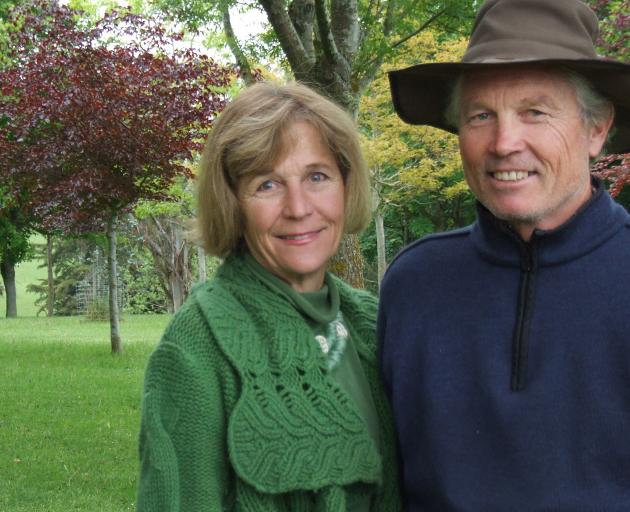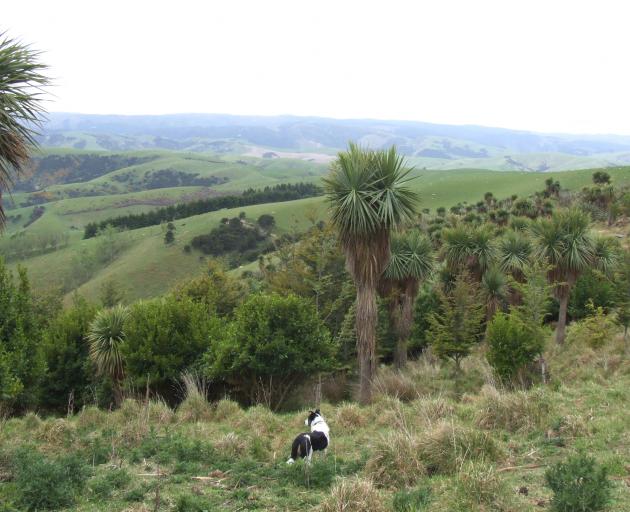
The 2017 Husqvarna South Island Farm Foresters of the Year, Mark and Marjorie Hay, will host a field day on their Tuapeka West farm tomorrow afternoon. Agribusiness reporter Sally Rae visits their impressive operation.
As Marjorie Hay surveys the extensive plantings on Glenayr Farm, she says the vision is for the future more than the present.
After years of hard work on the South Otago property she farms with husband Mark, her enthusiasm is undiminished.
''It's so exciting to think you've left that mark on the landscape,'' she says with her infectious energy.
The hills of Glenayr, at Tuapeka West, could not be much further removed from the bustle of Boston, where she used to live. But she has embraced the rural lifestyle and put her design skills to spectacular use, both in her garden and on the farm.
Just how a South Otago sheep and beef farmer met an American-born designer sounds a bit like something out of a romance novel.
Mrs Hay had come to New Zealand to be a guest lecturer in the design department at the University of Canterbury.
The pair sat beside each other at Wellington Airport, where Mr Hay was nursing a broken leg. His future bride - ''being a chatty American'' - asked him about being a sheep farmer.
She visited the farm after she finished her teaching stint and never thought she would see him again. But the pair started corresponding and he came to visit her in Boston, where she was teaching part-time and had her own design business.
She returned to New Zealand the following year to do a longer stint at university, stayed with Mr Hay and the pair got engaged.
Describing herself as ''definitely a city girl'', she said moving to Otago was a massive change but one she adapted to.
This year, the couple were named the Husqvarna South Island Farm Foresters of the Year, appropriately receiving a chainsaw for their efforts.
Tomorrow, they will host a South Otago Farm Forestry field day on their property on Athenaeum Rd, starting at 1.30pm.
South Otago Farm Forestry Association chairman David Vollweiler said their property was an ''outstanding example'' of the benefits of forestry and amenity planting.
The field day was also timely given there was a lot of interest in forestry due to record log prices, an improved carbon market and a new Government wanting to increase tree planting.
Mr Hay, who grew up in Motueka and was the son of a dentist, was not always going to be a farmer.
His grandfather had wanted to be one but could not afford a farm. When he retired from the railways, Mark's father was looking for an investment and bought Glenayr, and Mark's grandfather looked after it with help from managers.
Mr Hay recalled coming to the farm every Christmas as a child, he and his five siblings packed into the old Land Rover. He never considered being a farmer himself until he came to the farm after a stint at university and enjoyed it.
Glenayr had grown from 500ha when he first arrived to 850ha, with the purchase of additional land.
When they took over, a ''little bit'' of shelter belts and a small block of Douglas fir had been planted.
In about their second year, they milled some trees his grandfather had planted and made a good profit at a time when sheep farming was tough, which helped get him enthusiastic about trees.
They started planting some smaller blocks of Pinus radiata and Mr Hay admitted they did not really know what they were doing. Fortunately, they had some good advice from locals; South Otago was a very good ''hub'' for farm forestry.
From there, they turned their attention to Douglas fir. It was all about ''horses for courses'' - Douglas fir was far more suited to the altitude and weather and was also much nicer to look at, Mr Hay said.

A long-term view became ''paramount'' for the couple, who have two children, and once they felt they had enough Pinus radiata to be sufficient for succession planning, they turned their attention to amenity planting.
When the couple moved to the house they now live in, there was no garden. Despite having never done any gardening, Mrs Hay quickly became a ''fanatic''.
Possibly it was because she was a designer but she ''just took to it'', while her husband got her very interested in trees. And it was like having a ''giant palette'' with which to work.
She went on a planting spree at the rear of the house, keen to re-create an area of land by a lake in Ohio, owned by her family, that had a lot of trees and that she really missed.
Twenty-four years later, it was now like a woodland with its ''beautiful'' autumn colours, along with about 6000 daffodil bulbs planted underneath.
Then Mr Hay offered her a gully that had been cleared. Starting with a ''clean slate'', she designed the plantings and put in about 4000 plants.
That got her excited about doing more amenity plantings around the farm, each time with a colour scheme involved.
The Hays were still planting after several decades, mostly shelter belts or amenity plantings, and had about 102ha of trees in total.
Mr Hay attributed his love for native plants to his mother, who had a lovely garden in Motueka, featuring natives.
Exotic trees were also planted on Glenayr, with the likes of flowering cherries providing a contrast to the landscape.
The couple wanted to create an environment for themselves as well as their stock, and they got a lot of pleasure from it.
''It just makes you feel good when you see them grow. There's something pretty cool about watching trees grow. It feels like you're doing something good for the environment as well,'' Mr Hay said.
The benefits of plantings were widespread. Shelter was particularly important and it was habitat for a variety of birdlife, including bellbirds and tui. There were also three breeding pairs of native falcon on the farm.
On-farm plantings were ''happening a lot more'' than a lot of people might imagine. ''A lot of farmers around here have gone down that track,'' Mr Hay said.
The Hays had a joint venture with Mr Hay's Dunedin-based sister with a 40ha block of trees. It was a good opportunity for her to get involved, and it was interesting. ''Putting money in the bank is not that exciting,'' he mused.
There had been a ''fair bit of trial and error'' over the years and if the field day helped people to not make the same mistakes, that would be a good result, he said.
One of the speakers will be Paul Molloy, from Southern Forests, talking about carbon.
Mr Hay had learned a lot from his involvement with the South Otago Farm Forestry Association, along with a farm forestry discussion group.
The couple were keen to see more members and get ''new blood'' on board.
It had been very interesting to be involved with people who were so passionate about trees, Mrs Hay said. She would like to see more women get interested, as it was so satisfying.
''I just think it's the best thing you can do. I just hope I can keep doing projects. It's been an enchanting life,'' she said.
